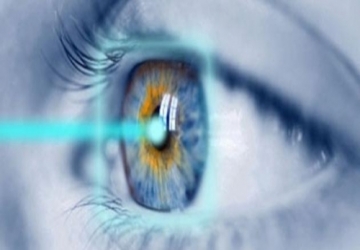Photochemotherapy
Photochemotherapy is considered one of the most recent treatment methods that increase the mechanical and biochemical tolerance of the collagen that contains the corneal fibers.
And with the question of Dr. Muhammad Hantira - Honorary Assistant Professor - Eye Department - Umm Al-Qura University - Saudi Arabia
It has been shown that this treatment, which consists of the interaction of ultraviolet rays with riboflavin (vitamin B2) on collagen tissues, has proven highly effective in increasing the stiffness of corneal tissues to about three times the stiffness before the treatment, and thus not convex it as observed in cases of keratoconus.
The importance of riboflavin lies not only in the interaction with the radiation, which leads to an increase in the hardness of the cornea, but also in its ability to prevent the penetration of ultraviolet rays into the eye and thus not damage the rays to the lens or the retina.
It is evident from the study of weak corneal cases that the transverse bonds responsible for the interconnection of collagen fibers are few in number for one reason or another, usually the genetic or genetic makeup plays a role in this defect, so this photochemical therapy would double these cross-links and thus increase the hardness and resistance of collagen tissue as it is. Noticeable naturally in old age.
Who needs this technology?
Dr. Hanatera recommends this treatment for all people who suffer from an increase in the degree of curvature or dentation of the cornea, and the doctor proves this by means of successive measurements of keratoconus.
• Keratoconus.
• Peripheral pellucid lysis: This disease is one of the corneal histolysis diseases.
• due to the weak result of some LASIK operations.
• Reducing farsightedness resulting from the operations of corneal stripping and vision stabilization.
Benefits and advantages of photochemotherapy
• The treatment results are permanent
• Simple treatment in one session lasting an hour or less
• It does not require long follow-up after a treatment session
• The treatment does not require hypnosis
• It stops corneal curvature and helps flatten the cornea
• Safe treatment, without medical reservations
• Treatment without injection or stitching
• Without making any incisions or wounds in the cornea
• Fast recovery
How to perform photochemical therapy
Dr. Hantereh indicated:
- That the treatment is performed while the person is lying in a sterile room, after putting anesthetic drops.
- The thickness of the cornea is measured before starting the treatment and during the treatment to find out the changes in the thickness of the cornea.
- The doctor performs simple scratches in the corneal cortex so that the substance riboflavin penetrates into the middle of the corneal tissue and is saturated with it, and it is worth noting that these new scratches in the corneal cortex are completely healed within 2-3 days.
- The doctor or one of his assistants puts drops of riboflavin on the cornea at a rate of one drop every minute or two, and the instillation process continues between 10-30 minutes
The riboflavin instillation process continues while ultraviolet rays are shed on the cornea of 365 nm wavelength for another 10-30 minutes, depending on the focus of the rays on the cornea.
- The eye is washed with a sterile solution and a soft contact lens is placed to protect the cornea for 2-3 days.
